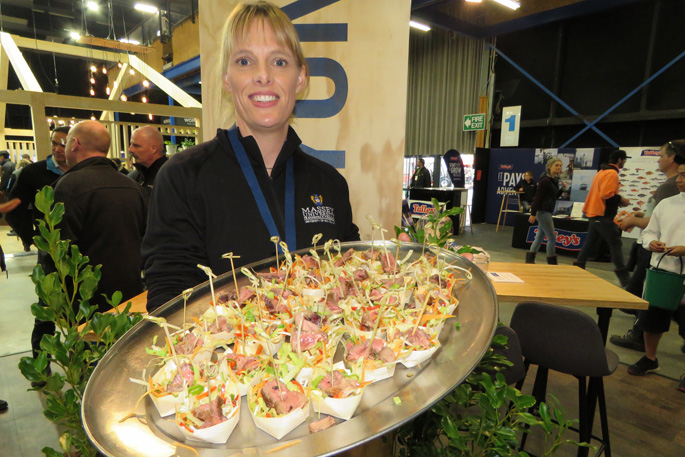As a delicious aroma of freshly-cooked beef wafted from Massey University’s Fieldays stand, visitors eagerly lined up to try New Generation Beef.
Here, Dr Nicola Schreurs was serving a new beef product that could help find a use for surplus calves out of the dairy industry.
The potential new product is produced by rearing calves sourced from the dairy industry up to one year of age.
Nicola, who has been working on the product for two years, says the research has the potential to spawn a brand-new beef industry that could one day phase-out the slaughter of bobby calves.
“This new product isn’t veal; we are developing a new, grass-fed, full red-meat product that we hope will require less resource and deliver a more sustainable beef production.”
Nicola says New Generation Beef could be used to mitigate welfare concerns associated with bobby calves, while dealing with the large animal resource opportunity coming out of the dairy industry.
“There is approximately two million surplus calves produced by the dairy industry and if we grew the majority through to the traditional two or three years of age, there wouldn’t be enough land to feed and grow them.”
But processing calves before one year of age creates an accelerated system and offers benefits to farmers such as being able to get the animals off-farm before winter.
“This means you don’t need to over-winter them, which for some farms with sensitive soil would minimise pugging issues.”
It also eliminates land-owners needing to source and supply extra feed, which is often required by animals during colder moths.
And while Nicola says a negative connotation is associated with beef production – “that it uses lots of resources and water, and is quite polluting in terms of greenhouse gases” – young animals are in their most efficient growth phase. And in terms of their ability to capture nutrients and retain it in their body, this period is their most efficient.
“We’re currently trying to validate that – potentially there’s less nitrogen going on soils and less greenhouse gas from growing cattle to only 12 months. We hope that smaller animals will not produce as much excreted nitrogen and gas compared to a larger beef animal.”
Nicola says nothing is done to the meat – it is naturally lean and tender – and her team is now trying to identify potential markets for it. “We’re asking the meat processor and marketers if they are able to identify a market for the product; and if the there is potential for it to work through their processing facilities as there might be challenges with using current beef processing facilities due to equipment designed for larger animals.
“The other consideration we need to discuss with the processors is if taking the animal to 12 months and a lighter carcass will allow for a strong price that makes it worthwhile to farmers as well as meat producers and marketers.”
Nicola says the snag is smaller animals will have a lower per head yield – currently NZ’s beef production is programmed towards as much yield as possible from each animal.
“However, we consider that the stocking rate could be altered to get the same amount of carcass per hectare compared to current beef production systems.
At Fieldays, feedback from NZ’s rural community was positive. “Dairy farmers and beef finishers really like the concept. We also think commercial calf-rearers may be interested as dairy farmers don’t necessarily want to raise a whole lot of calves. So we’re working through all these scenarios and challenges along the way.”
As for the meat’s taste? “People love it and the key thing is it’s tender and easy to eat. With a young processing age you can almost guarantee it will be tender meat. And our research shows that regardless whether the meat is aged or not, it has the same level of tenderness.
“This means we could get it to markets sooner and it may be ideal for Asian markets closer to home.”
While New Generation Beef is only at pilot stage, Nicola says it does offer a different way to think about beef production. “We see this innovation as a new beef product coming from a new generation of farmers, for the new generation of consumers.”



0 Comments
Leave a Comment